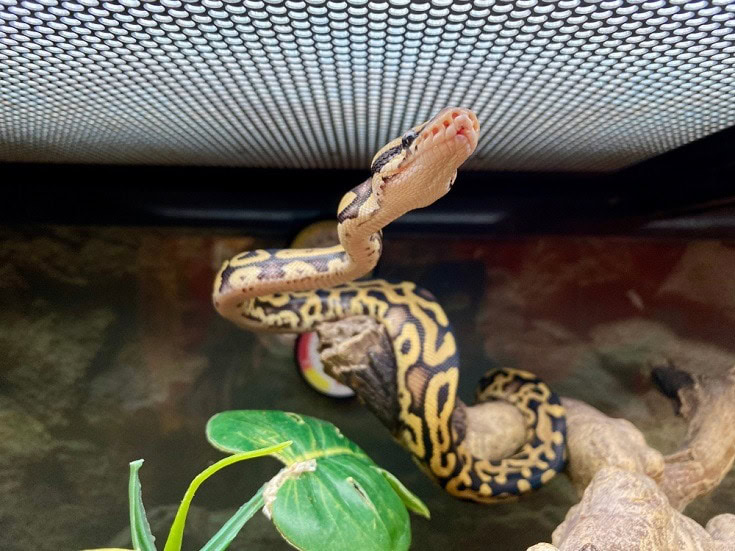The ball python is a beloved pet that gets its name from its defensive strategy: scrunching up into a ball. Some people call it the rock python because all it seems to do is stay on the ground. But do ball pythons ever climb? Ball pythons climb a little bit, and their enclosure should allow some space to do that. However, they are not great climbers, so those climbing elements should support them well while they climb. Read on to find out more about ball pythons and climbing.
As a ball python owner, you likely want to create the best possible environment for your scaly companion. While these snakes spend much of their time on the ground, providing climbing opportunities can greatly enrich their lives. In this comprehensive guide, we’ll explore why climbing matters for ball pythons the best climbing options to use important safety considerations, and frequently asked questions.
Why Should You Offer Climbing Structures?
Though classified as terrestrial, ball pythons absolutely reap benefits from climbing in captivity. Here are some of the key advantages
-
Physical Exercise: Climbing encourages much-needed activity to maintain muscle tone and prevent obesity. Sedentary snakes are prone to health issues.
-
Mental Stimulation: Exploring vertical space keeps your snake’s mind engaged and prevents boredom. A mentally stimulated snake is a happier, healthier snake.
-
Thermoregulation: Positioning climbing items near heat sources allows your ball python to comfortably access optimal temperatures. This aids in regulating their body temperature.
-
Natural Behavior While mostly ground-dwelling ball pythons do climb in the wild. Providing climbing opportunities allows them to express natural behaviors.
-
Enrichment: Climbing structures make the enclosure more complex and interesting. This enrichment is vital for good physical and mental health.
Clearly, climbing offers major benefits for your ball python’s wellbeing. Let’s look at suitable climbing options.
Choosing Safe, Enjoyable Climbing Structures
Selecting appropriate climbing items is crucial for both safety and providing an enriching experience. Here are some top choices:
-
Natural Wood: Sterilized logs and branches from non-toxic trees make excellent climbing surfaces. Hardwoods like oak are ideal. Always disinfect before use.
-
Cork Bark: Lightweight and mold-resistant, cork bark offers a stimulating natural texture for climbing.
-
Artificial Vines: Bendy rubber or plastic vines allow you to create climbing trails when anchored securely.
-
Rock Ledges: Artificial rock formations with ledges and crevices provide opportunities to climb and hide.
-
Commercial Climbing Structures: Some companies offer climbing pieces designed specifically for reptile enclosures.
The key is choosing structures that are completely sturdy and appropriately sized for your ball python. Avoid anything slippery or unstable. Position items thoughtfully to allow for thermoregulation and exploration.
Key Safety Considerations
When offering climbing enrichment, always keep safety top of mind:
-
Ensure all structures are firmly secured and stable enough to support your snake’s weight.
-
Pick climbing surfaces with adequate texture to provide a good grip. Smooth surfaces can cause slipping.
-
Choose sizes appropriate for your particular ball python to prevent entrapment.
-
Regularly clean and disinfect structures to prevent bacteria or mold.
-
Carefully supervise your snake’s initial interactions with new climbing items to ensure safety.
-
Inspect structures for wear and tear, replacing any damaged pieces promptly.
With sensible precautions, you can provide a fun climbing space that also prevents potential injuries.
Frequently Asked Questions
Can ball pythons actually climb if given the opportunity?
Absolutely! While some individuals are more avid climbers than others, most ball pythons will enthusiastically explore quality climbing structures when provided.
How high should climbing items be?
Aim for a variety of heights – some low-lying and others taller – to provide a spectrum of climbing opportunities. Just ensure the height is stable enough to be secure.
What’s the best climbing material?
Natural wood and textured commercial reptile products are ideal. Cork bark is another wonderful option. The key is avoiding slippery surfaces.
How often should I clean climbing items?
About once a week, disinfect all structures with reptile-safe products. This prevents potentially harmful bacteria and fungi from accumulating.
Can I use regular branches from my backyard?
You can, but take precautions. Ensure the tree species is non-toxic and the branch has no pesticide residue. Always thoroughly sterilize before use.
Should I remove climbing items when handling my snake?
No need to remove them for handling, but avoid interacting with your snake right after feeding as they need uninterrupted digestion time.
My ball python never climbs. Should I be concerned?
Not necessarily. Some ball pythons simply don’t climb often. Ensure the structures are securely positioned and sized appropriately. If your snake is healthy otherwise, it’s likely fine.
What if my ball python gets stuck while climbing?
Gently assist your snake in freeing itself if stuck. If this occurs frequently, reassess the structure’s safety and potential replacement.
By thoughtfully incorporating climbing into your ball python’s habitat, you provide crucial enrichment that supports their health and happiness. Let your snake’s climbing adventures begin!

What Do Ball Pythons Like to Climb?

In order to create more excitement in your ball python’s life, you can give him a few things to explore and climb on in his terrarium. This is not necessary, though, as many pet ball pythons do just fine without climbing objects in their cage. It’s not known for a fact that ball pythons like to climb at all, but they do climb around when there is an opportunity to.
Ball pythons, though they can climb, are not known to be good at it. Ball python owners have reported their pet snakes falling from a clumsy climb. Make sure your terrarium has a soft landing for your python should he fall down from one of these climbing endeavors.
Many people wonder if ball pythons can climb up walls. It may ease your mind to know that they cannot climb up vertical walls. Thin snakes climbing up a rough, uneven surface like a rock wall will be able to scale a wall, but this isn’t true for ball pythons. Ball pythons cannot climb walls because their bodies are very thick and their muscles are not built for it.
The climbing objects in the terrarium should be slanted objects that are slightly rough, sturdy enough to support your python’s weight, and not too far off the ground. Some great options are fake bark propped up in a slant or a plant bar that’s slightly elevated (but not too tall).
